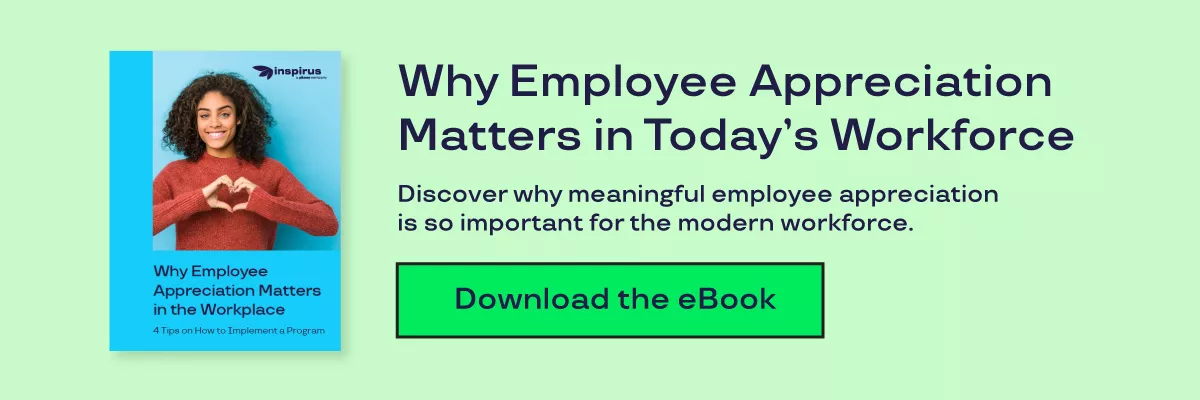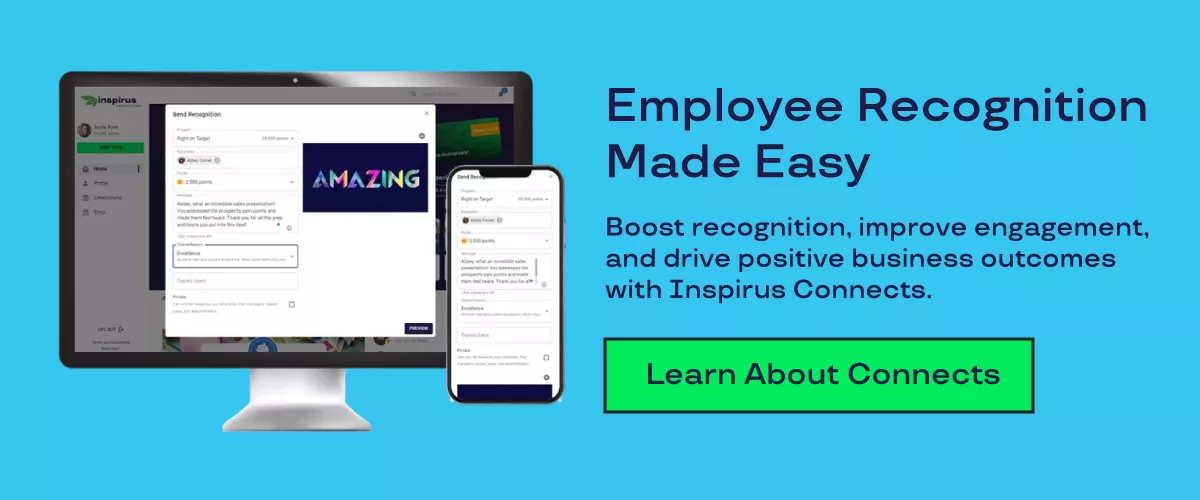
The Art of Creative Employee Recognition Programs
March 6, 2024
Gone are the days when an annual pizza party was considered enough to recognize and appreciate employees. As the workforce evolves, so do employee expectations.
Today, employees want more than just a paycheck. They want to feel seen, valued, and appreciated by their organization. So, what’s the best way to ensure they feel appreciated? Implementing an employee recognition program that celebrates achievements and empowers employees is a great place to start.
These programs play a key role in cultivating healthier work environments that empower, motivate, and celebrate their employees. With the challenges of the modern workforce, employee recognition programs are no longer a ‘nice to have’ for organizations; they are table stakes. Organizations must implement tailored programs to create a positive work environment, boost engagement and, ultimately, drive organizational success.
This blog post explores the nuances of building effective recognition programs, why recognition matters in the workplace and creative ways to appreciate employees.
How to Build an Effective Employee Recognition Program
Building a successful employee recognition program starts with creating a clear recognition strategy that aligns with your company’s objectives and culture.
Here's a few tips on how to build an effective employee recognition program:
#1 Create a Clear Plan
As you start the process of planning out your employee recognition program, begin by defining the objectives. Identify what you want the program to achieve. Are there specific KPIs you want to track? What are the OKRs for the program? These objectives can range from boosting morale and engagement to encouraging specific behaviors aligned with the company’s values.
In addition, you should use this period to identify the budget you can allocate towards the program, the timeline for launching the program and outline a plan for the program’s maintenance.
#2 Select a Recognition Method
Once you’ve outlined your goals and budget for the program, it’s time to determine which recognition method(s) are best-suited for your program. Consider the following types of recognition programs:
- Peer-to-peer recognition platforms (monetary or non-monetary)
- Structured recognition programs (i.e. annual or monthly awards, etc.)
- Team-based recognition
- Service anniversary rewards
- One-time programs for special occasions (i.e. holidays, birthdays, etc.)
Ensure the method you select is inclusive, allowing all employees an equal opportunity to be recognized. Select a method that caters to your staff’s different needs and preferences. Lastly, consider the reward choices for your employees – ensure your approach can suit a multi-generational workforce.
#3 Communicate and Launch the Program
After the program has been selected and set up, develop a plan of action for announcing the program and encouraging participation. Select multiple channels to communicate the new program, including email, internal newsletters, town halls and the company intranet.
Once a communication plan is in place, you’re ready to launch the employee recognition program! Here are a few tips for the launch:
- Make it memorable: Consider launching the program with an event or announcement that highlights its importance to the organization.
- Lead by Example: If you are implementing a recognition platform, make a few initial recognitions during the launch to demonstrate how the program works and to start it off with positive momentum.
- Provide Training: If you are launching a platform, provide documentation on how to access and use it. On the other hand, if you have a one-time program, notify employees about the program in advance, and provide details about what to expect.
After the program has launched, continually communicate with the staff about the programs. Avoid setting and forgetting the program for maximum effectiveness! Keep your program in employees’ minds with regular updates, stories of recognition, and reminders of the program’s benefits and best practices for participating.
#4 Hold Leadership and Management Accountable
Leaders should actively participate in the program, recognizing contributions and setting an example for their team. Consider incorporating recognition activities into leadership and management performance evaluations to ensure ongoing commitment to the program. In addition, you can offer training sessions to managers on how to effectively recognize and motivate their teams within the program’s framework.
#5 Measure Progress and Adapt
Schedule regular reviews of the program’s performance against your KPIs to assess its impact and identify areas for improvement. One of the most important parts of creating a successful recognition program is adjusting the program as needed. Consider implementing a survey to collect feedback on the program to ensure it remains relevant, valued, and effective. Once you’ve gathered enough feedback, see where you can enhance the program and make changes to boost participation and success.

Ways Employee Recognition Builds Better Managers
Recognition programs not only benefit employees but also help in developing better managers. The manager-direct report relationship is one of the most important roles within an organization. Managers influence the employee experience and can easily impact an employee’s perception of the company.
When managers actively recognize their direct reports and teams’ success, their team is more likely to be engaged, feel empowered to do their best, and be more collaborative. This not only motivates their team to strive for excellence but also encourages managers to develop a deeper understanding of their team’s efforts and achievements, leading to improved rapport and engagement. In fact, 37% of employees cite that the best way to improve their engagement is by receiving recognition from their supervisors.
By celebrating their team’s contributions, managers can instill a sense of empowerment among their team members. As a result, this will strengthen the manager-direct report relationship and enable employees to contribute fully to their role and organization.
The Positive Impact and ROI of Recognition
Employee recognition is a powerful tool that is often overlooked in organizations. When employees are recognized, celebrated, and motivated, good things follow. A robust employee recognition program can have a significant impact on an organization – impacting everything from culture to retention to business outcomes.
By acknowledging and valuing employees’ contributions, companies can experience positive business outcomes, including:
- Improve job satisfaction and employee retention. Recognized employees are usually more satisfied with their job, and thus, they are less likely to seek a job elsewhere. In fact, employees who are recognized are nearly six times more likely to stay at their job.
- Increase employee engagement and enhance productivity. When employees are recognized, they can be motivated and inspired to continue their hard work and motivated to strive for excellence. And research by Deloitte validates this: recognition has been proven to increase employee engagement, productivity, and performance by 14%.
- Provide excellent customer service. Client-facing employees that feel supported and recognized are more motivated to provide exceptional service, leading to improved customer satisfaction and loyalty.
- Strengthen teams’ bonds. Teams that prioritize recognizing their team members will have stronger bonds, be more collaborative, and have higher trust. In fact, highly recognized teams agree that they trust their everyday team members.
- Boost employee morale and happiness. Regularly acknowledging employees’ hard work and achievements can lead to a more joyful and fulfilling work environment, significantly boosting morale and happiness.
- Cultivate a positive work environment. Frequent recognition can help cultivate a positive company culture where employees are more engaged, satisfied and aligned with organizational goals.
Celebrating and appreciating the people who power your organization – your employees – can lead to positive business outcomes and improve your bottom line.
Creating a Culture of Recognition
Implementing an effective recognition program requires a thoughtful strategy that aligns with your organization’s values and goals. Your recognition strategy should be inclusive, easily integrated into the employees’ workday, accessible by the whole organization and tailored to your employees’ needs.
Like all strategic initiatives, it’s not uncommon to have challenges in implementing and maintaining these programs. When an employee recognition program is first launched, there is often a lot of excitement and energy around it, but as employees get busy with their daily tasks, they may forget to use it. It’s critical that recognition program administrators continually communicate about how to use the program and the benefits of using it. Other common obstacles HR teams may face include budget constraints, buy-in from leaders and managers, perceived fairness and inclusivity, accessibility, and maintaining relevance.
One of the best ways to combat these issues is by getting buy-in from leadership. Their role in fostering recognition cannot be understated. As we all know, leaders set the tone for the organizational culture and their attitudes towards recognition can have a profound impact on participation. They must lead by example, consistently recognizing achievements on their teams and encouraging their departments to participate. This top-down approach ensures that recognition becomes a core part of the organization, encouraging managers and employees at all levels to participate.
Types of Employee Recognition Programs
Understanding the different types of recognition programs can help you implement the right strategy for your organization. Let’s explore a few of the different types of employee recognition programs.
Formal vs Informal Recognition
There are two main categories of employee recognition: formal and informal. Formal recognition involves structured programs or ceremonies where employees are acknowledged for their contributions. This might include annual awards, milestone celebrations, or employee of the month programs. These programs are often planned and follow a set of criteria.
On the other hand, informal recognition is spontaneous and can occur at any moment. This type of recognition consists of the day-to-day acknowledgment of an employee’s hard work, such as a verbal thank you or a quick note of appreciation. Informal recognition is flexible and can be more personal, making it a powerful tool for immediate positive reinforcement.
Individual vs. Team-Based Recognition
Individual and team-based recognition are equally important. Individual recognition focuses on the achievements of a single employee, highlighting their specific contributions and achievements. Team-based recognition, on the other hand, is focused on celebrating the collective achievements of a group working towards a common goal or objective. This type of recognition reinforces the importance of collaboration, teamwork and shared success.
Tangible vs. Intangible Rewards
When it comes to rewards for recognition, there are two different types: tangible and intangible. Tangible rewards are physical or monetary awards given to employees as recognition for their work. This could include bonuses, gifts, certificates, or any other physical token of appreciation. Intangible rewards are not physical rewards for employees to have or use; however, they can still hold an immense value in recognizing employees. These can include verbal praise, written acknowledgment, and professional development opportunities.
How to Creatively Recognize Employees
Sometimes, the most effective recognition comes from creative gestures. These small tokens of appreciation often have a more personal touch and capture everyone’s unique contributions. From something as small as a monthly employee award to a grander gesture like catering lunch, finding creative ways to recognize your employees can go a long way in boosting morale, engagement, and job satisfaction.
To ensure your recognition is impactful, make sure to align it your company’s values and culture. Consider your employees’ needs and preferences and find creative ideas that appeal to the majority.
Keep in mind, though, your gesture doesn’t have to be extravagant or break the bank. While grand gestures can be nice from time to time, simple, creative tokens of appreciation can be just as impactful, if not more.
Simple and Creative Employee Recognition Ideas:
- Team trophy: The trophy can be a stuffed animal, a wand, or any other object that reflects your team's personality.
- Sticky notes: Leave surprise notes of appreciation on employees’ desks.
- Virtual party: Celebrate your remote or hybrid employees with a virtual party.
- Surprise treats: Surprise employees with a sweet treat like doughnuts.
- Handwritten note: A personal goes a long way. Pass out handwritten notes that express gratitude.
- Social media praise: Spotlight your employees publicly on social media with a Q&A.
- Pay it forward: Encourage employees to recognize each other. Implement a peer-to-peer recognition platform to incentivize recognition.
- Wall of fame: Highlight employees who go above and beyond monthly with a wall of fame.
Employee Recognition Ideas for Employee Appreciation Day
Employee Appreciation Day is an annual event that occurs on the first Friday of March. It’s a special day dedicated to recognizing and celebrating your hardworking staff and provides companies with the perfect opportunity to give back to their employees and say “thank you” to them in a meaningful way.
Here are a few ways you can celebrate your staff on Employee Appreciation Day:
- Personalized thank you videos from leadership
- Feature employees in a company-wide newsletter
- Offer the day off for employees to recharge and relax
- Organize a team-building activity to strengthen team bonds
- Pass out custom awards or trophies for unique achievements
- Give employees a swag package with company branded merchandise
- Cater lunch for your staff to say “thank you” for their dedication
- Send employees a reward of choice with a digital recognition program
- Host a themed Employee Appreciation Day event
- Hand out handwritten notes from direct supervisors
- Provide a wellness package or subscription
- Provide gift cards to a popular and trusted brand
Continue Recognition Efforts Throughout the Year
The impact employee recognition has on your organization depends on how frequently your employees are recognized. Employee recognition should not be a one-off event, or just another item on a to-do list to check off. The more often employees receive recognition, the more likely it will shape and transform your organization’s culture - and influence business outcomes.
Find ways to celebrate your employees throughout the year whether it’s milestones, special occasions, or big achievements. Invest in training and resources for your leadership team and managers to ensure they understand the importance of frequent recognition and can lead by example. This regular recognition will keep your staff’s morale high, boost engagement, improve job satisfaction and retention, and ultimately, drive positive business outcomes.
Streamline Recognition with Inspirus
Looking for an easy way to streamline your employee recognition programs? A digital recognition platform like Inspirus Connects makes recognizing employees quick and easy.
Inspirus Connects provides a central hub for recognizing service anniversaries, celebrating achievements, encouraging peer-to-peer recognition, and rewarding employees. Talk with one of our specialists to see how we can help you streamline recognition and boost engagement.





